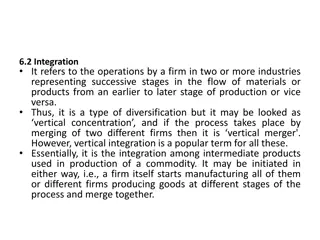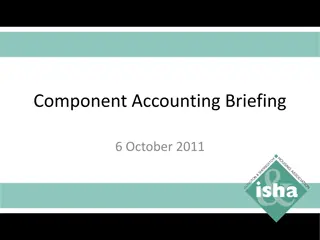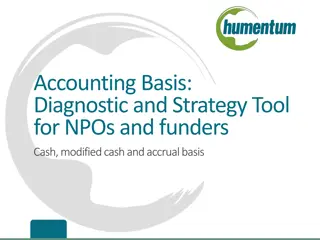
What Are the 7 Strategic Planning Steps for Accounting Firms
It is very important to note that strategic planning is a vital component of any organization including accounting firms. Every business requires a strategic plan suitable to its niche, and this makes Accounting firms such as TaxlinkCPA to remain rel
Download Presentation

Please find below an Image/Link to download the presentation.
The content on the website is provided AS IS for your information and personal use only. It may not be sold, licensed, or shared on other websites without obtaining consent from the author. Download presentation by click this link. If you encounter any issues during the download, it is possible that the publisher has removed the file from their server.
E N D
Presentation Transcript
What Are the 7 Strategic Planning Steps for Accounting Firms? It is very important to note that strategic planning is a vital component of any organization including accounting firms. Every business requires a strategic plan suitable to its niche, and this makes Accounting firms such as TaxlinkCPA to remain relevant competitively secure clients and be sustainable in the long run. In this blog, I have chosen to discuss the seven strategic steps of strategic planning that is crucial for accounting firms.
1. Vision and Mission statement The first fundamental step in strategic planning therefore is to give a proper statement of what the firm wants to achieve and for what purpose it exists. Vision defines the position of your company in the future, and mission gives the idea of the organization and the service it delivers to its clients. For instance, at TaxlinkCPA, a vision may be to be the most appreciated accounting firm in Canada offering value added services to clients. Key Questions to Consider: What vision do we have for the firm in the next five or ten years down the line? What is our business, and how do we support our clients, or what is our mission on the market? 2. Conduct a SWOT Analysis SWOT stands for Strengths, Weaknesses, Opportunities and Threats and it is a tool that can assist in determining your organisations position in the market. The knowledge of the four areas will enable one to create methods that will see him or her working on the strengths and on the other hand avoiding weaknesses and threats while exploiting opportunities. It can be considered that this analysis serves as a strong basis for your strategic plan. Steps for a SWOT Analysis: Below provide your firm internal strengths and weaknesses. To identify market opportunities that exist outside the organisation. Understand threats that may be in existence in the environment, competition or even macro-economic factors for instance a recession period. 3. Set SMART Goals But now that the concept of the vision and analysis of the SWOT have been defined, it is time to set explicit objectives. SMART goals are those goals that are Specific, Measurable, Achievable, Relevant, and Time bound. Such goals outline the development plan for your firm and guarantee tangibility in your strategic agenda. Examples of SMART Goals: Become a client focused company by creating awareness of the need to retain customers and increasing the overall customer retention rate by 15% within the next year. Launching of new services and products: Currently, the firm only offers credit-based services, but for the next fiscal year, the firm should expand and add the advisory service among others. Give attention to staff training programs in order to have a better service delivery.
4. Develop a Marketing Strategy Marketing plays a very vital role in ensuring that the corporate house gets new clients and also retains the existing ones. Marketing should therefore be directed to the right client le and should be in conformity to your firm s objectives. A few of the strategies that should be embraced may include digital marketing, content creation, networking, and client referrals. Key Marketing Tactics: Promote the website by carrying out SEO in order to attract clients who make their inquiries on the web. Develop high-quality pieces and resources that prove your worth and knowledge in your blogging type, these include; blog articles, White papers, Webinars among others. Get in touch with potential clients in social media sites and business related sites such as LinkedIn. 5. Enhance Client Services It is self-understood that clients satisfaction is the foundation for development of the accounting firm. It can be as simple as realizing that to sustain and expand the number of clients you have one has to work at developing the standard of offered services. This may involve such measures as introducing new added-value services, enhancing the communication platform and equipping your team with the most current information on satisfying the customers needs and expectations. Client Service Strategies: Surveys should be done to the clients to help in finding out their experience and any issue they may have. Develop new services by analysing the needs of the clients and the developments in the field. Continuously invest in your employees through training and development so that they can give their best in terms of offering service. 6. Implement Technology Solutions In the contemporary society, technology is a critical-factor in the success of accounting firms through firm efficiency. Applying appropriate technologies and software solutions will help to optimize and other processes, increase effectiveness and participants satisfaction. Cloud based accounting software, client portals and automation tools should be considered while dealing with competition. Technology Solutions to Consider:
Computerised internet based accounting software to make required financial information available and up to date. The use of intelligent and automatic mechanisms for invoicing and payment tracking for purposes of increase cash flow. Web based applications for client to client transferring of documents and messages. 7. Monitor Progress and Adjust the Plan It is very important to understand that strategic planning is not a one time event; rather, this is a continuous process. Checking your progress from time to time and making changes to your plan based on the results is a must. Sample the impact of all your strategies and ensure that you have made a pointer to the key performance indicators (KPIs). Monitoring Techniques: Schedule meetings and calls on a timely basis to evaluate results or lack of progress from your objectives. Make and implement goals for key performance indicators concerning general business objectives ranging from the number of new clients to revenue and service delivery standards. Have a readiness to change when the market conditions or most of the clients insist on change or when one gets bored. Conclusion It is therefore important that any Accountants should have a strategic plan to enhance its success. If you master these seven steps: Step 1: Define Vision and Mission, Step 2: SWOT Analysis Step 3: SMART Goals Step 4: Marketing Strategy Step 5: Client Service Improvement Step 6: Technology Solutions Step 7: Monitoring you ll have all the tools you need to develop a detailed plan and push your firm forward. The idea at TaxlinkCPA is that in order to achieve our clients success and build a strong business ourselves, strategic planning is the most effective way to succeed in the accounting field.
















































